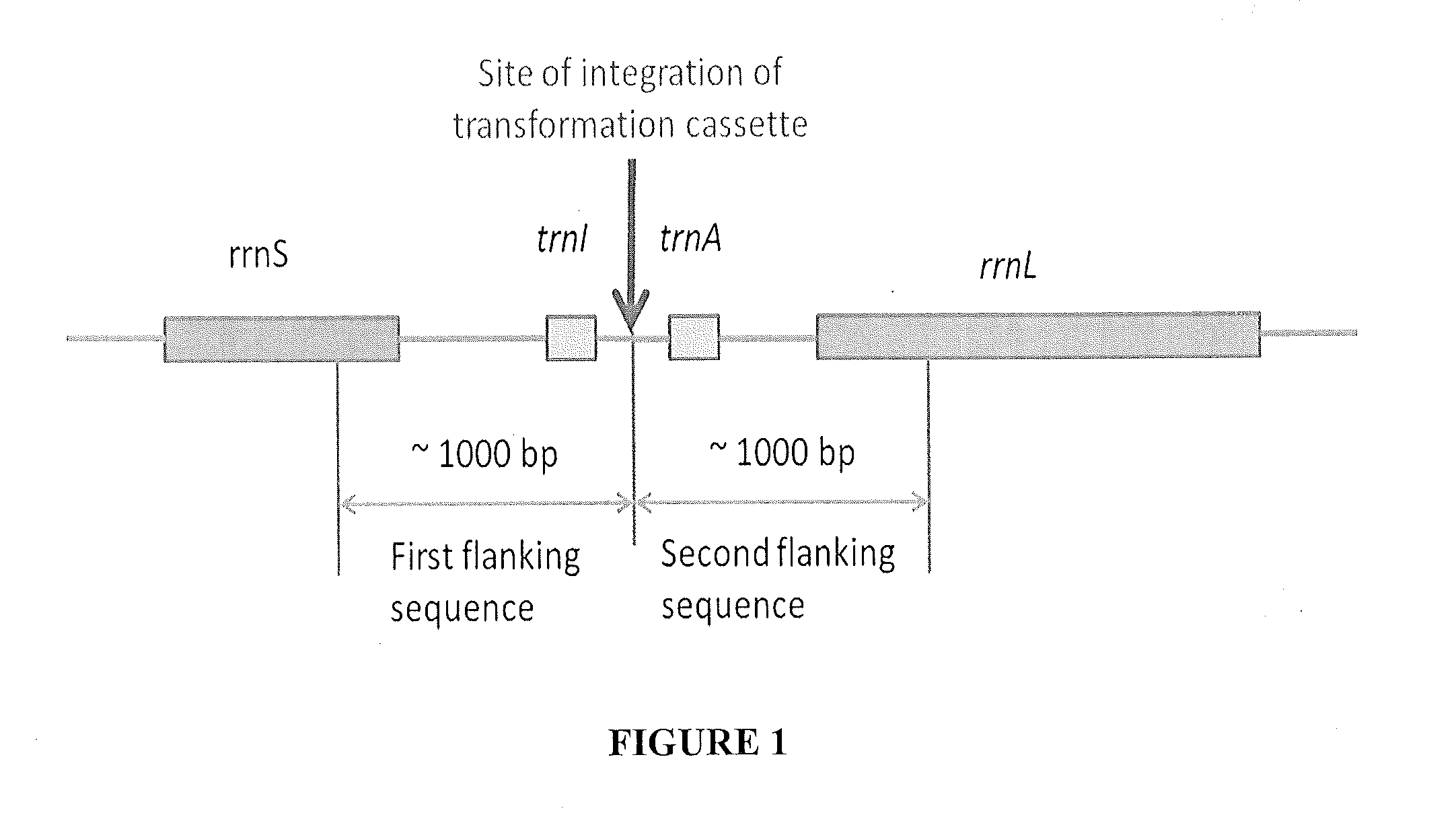Methods and compositions for the production of extremophile enzymes from green microalgae and cyanobacteria
a technology of extremophile enzymes and green microalgae, which is applied in the direction of lyase, transferase, enzymology, etc., can solve the problem of the relative high cost of biofuel production in these organisms, and outweigh the economic value of biofuel produced
- Summary
- Abstract
- Description
- Claims
- Application Information
AI Technical Summary
Benefits of technology
Problems solved by technology
Method used
Image
Examples
example 1
Codon Optimization of Transgenes
[0156]Codon usage bias is a species specific deviation from the uniform codon usage in the coding regions and is mainly based on tRNA copy number and genomic % GC. Codon usage bias of individual nucleotide sequences can correlate with expression levels. For expression of recombinant protein in green microalgae, codon-usage bias has been analyzed for Dunaliella salina homologs of Chlamydomonas reinhardtii highly expressed chloroplast and nuclear genes and reference tables generated for the respective codon preferences using OPTIMIZER as described in Puigbo et al. (Nucl. Acids Res. 35:gkm219 (2007)). Table 1 shows the codon usage bias for Dunaliella salina.
TABLE 1Dunaliellasalina codon usage bias for nuclearand chloroplast nucleotide sequences.Bias normalized to Amino Acid MaxHighly ExpressedChloroplasticSymbolAmino acidsCodonsNuclear GenesGenesAAlanineGCT11AAlanineGCC0.537630.1223AAlanineGCA0.978490.58273AAlanineGCG0.263440.11366CCysteineTGT0.450981CC...
example 2
Expression Cassettes (Nucleic Acid Constructs) for Chloroplast and Nuclear Transformation
[0160]The generation of expression cassettes for transformation is based on an adaptation of the overlap PCR technique (See, Horton. Molecular Biotechnology 3: 93-99 (1995); and Wurch et al, Biotechnology Techniques 12: 653-657. (1998)). Different fragments are first amplified with overlapping sequences to create full length product by combining overlapping fragments.
[0161]The nucleotide sequences to be expressed by the green microalgae are modified for codon usage using the codon usage tables generated for the specific green microalgae or cyanobacteria to be transformed (both nuclear and chloroplast genome codon usage) (see e.g., Table 1). Accordingly, the extremozyme nucleotide sequences are synthesized for optimal chloroplast or nuclear codon composition. In addition, the nucleotide sequences conferring traits that allow for the selection of transformed green microalgae cells and the nucleoti...
example 3
Transformation of Green Microalgae
Chloroplast Transformation.
[0172]Chloroplasts are transformed with the above described nucleic acid constructs using the biolistic method as known in the art and as described herein (Boynton et al. Science 240:1534-1538 (1988)). The size of gold particles and helium pressure is adjusted to obtain the highest transformation efficiencies.
[0173]Specifically, the D. salina cells are grown at about 27° C. in liquid culture comprising potassium nitrate, sodium chloride, potassium phosphate, bicarbonate and micronutrients. The D. salina cultures are grown under a light / dark regime or continuous light and supplemented with CO2-enriched air.
Preparation of the Microalgae Cells for Transformation:
[0174]The microalgae are concentrated by centrifugation and then resuspended in fresh media. Thus, for example, a 100 ml culture can be concentrated by centrifugation and then the pellet is resuspended in 1 mL of fresh media.
[0175]The cells are then embedded in soft a...
PUM
| Property | Measurement | Unit |
|---|---|---|
| temperatures | aaaaa | aaaaa |
| temperatures | aaaaa | aaaaa |
| temperatures | aaaaa | aaaaa |
Abstract
Description
Claims
Application Information
 Login to View More
Login to View More - R&D
- Intellectual Property
- Life Sciences
- Materials
- Tech Scout
- Unparalleled Data Quality
- Higher Quality Content
- 60% Fewer Hallucinations
Browse by: Latest US Patents, China's latest patents, Technical Efficacy Thesaurus, Application Domain, Technology Topic, Popular Technical Reports.
© 2025 PatSnap. All rights reserved.Legal|Privacy policy|Modern Slavery Act Transparency Statement|Sitemap|About US| Contact US: help@patsnap.com

